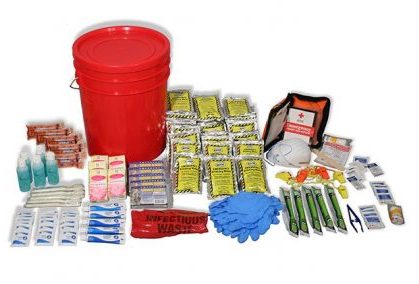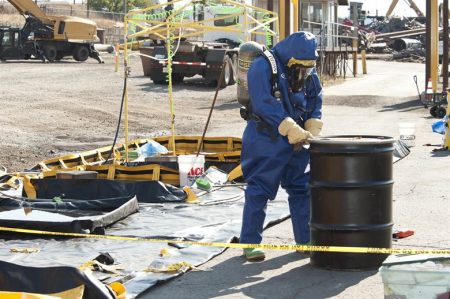Shelter in Place Kit
Sheltering in place is one of the best ways to protect yourself from a disaster when it’s too dangerous to go outside. It only makes sense that you should have supplies in a shelter in place kit on the off chance that you ever have to shelter in place, but what goes in that kit?
What is a shelter in place kit? A shelter in place kit contains everything that you need to safely seal yourself in your shelter in place room when a disaster has occurred that makes it impossible or dangerous to evacuate the area. The kit contains enough essential items to sustain you until the disaster has passed.
A shelter in place kit is required for most businesses but it also makes sense to have one at home in case of an emergency.
[wc_toggle title=“Table of Contents” padding=“” border_width=“” class=“” layout=“box”]
Building a Shelter in Place Kit
Sheltering in place is a way to protect yourself from an emergency or disaster situation that makes it too dangerous to leave the area that you’re in. Chemical spills, biological or nuclear contamination, tornados or other storms, and the outbreak of a pandemic can all lead to a shelter in place order being given.
What You Need to Build a Shelter in Place Kit
There are some companies that sell pre-made shelter in place kits like this one, but they’re not ideal and they don’t have everything that FEMA recommends in a shelter in place kit.
Most of the premade kits are missing first aid kits, duct tape, and plastic sheeting. If you decide to pick up a pre-made kit, make sure that you add these as soon as possible.
Shelter in place kit inventory:
- 5-gallon bucket with trash bags and kitty litter - You can pack most of the items in the 5-gallon bucket and it will double as a toilet by lining it with a trash bag and pouring about an inch of kitty litter in the bottom.
- 1 gallon of water per person for 3 days - A case of bottled water is just over 3 gallons.
- 3 days of non-perishable food per person - 1 package of S.O.S. emergency food rations is enough food for 1 person for 3 days.
- Household chlorine bleach (unscented with no additives) - You can add 16 drops per gallon of water to disinfect it or mix 1 part bleach to 9 parts water to make a cleaner.
- Battery-powered or hand-crank NOAA weather radio
- Flashlight with extra batteries
- First aid kit
- N95 dust mask per person to help filter contaminated air
- Plastic sheeting and duct tape to seal - Enough to seal all doors, windows, and vents in the shelter in place room.
- Baby wipes and garbage bags - For cleaning yourself and disposing of waste.
- Whistle to signal for help
- Wrench or pliers to shut off utilities
- Fire extinguisher
Additional items to add if your situation requires them:
- Diapers and formula if you need to shelter with an infant
- Food and water for pets
- Can opener if you pack canned food
- Books, games, puzzles or other activities for children
- Sleeping bags or extra bedding for comfort or in cold environments
- Mess kits, paper cups, plates and plastic utensils, paper towels
- Paper and pencil
- Prescription medications and glasses
What Makes a Good Shelter in Place Room
The key part of a shelter in place room is the ability to seal it and make it as airtight as possible. This means that you should try to find an interior room that doesn’t have windows. If you don’t have windows in the room there is less that you need to seal up and not having exterior walls makes it less likely that a storm can cause damage to you in your shelter in place room.
Many times, a room in the basement will be one of the better places to shelter in place. The walls are normally made of concrete and they’re surrounded by earth, making them even stronger.
Basements also normally don’t have a lot of vents and can give you access to the central air system so you can turn it off at the source.
The one time that sheltering in the basement isn’t a good idea is if the disaster involves the release of a chemical that’s heavier than air. In that case, it’s better to shelter in a room above ground level if you can.
What to look for when you’re choosing a shelter in place room:
- Interior room with no outside walls
- Doors that lock
- No windows
- Minimal vents, fans, and air conditioners
Why would you shelter in place?
A shelter in place order is given when a disaster has happened and it’s safer for you to stay inside and protect yourself than it is for you to evacuate.
What can cause a shelter in place:
- Industrial accident
- Chemical spill
- Break in a natural gas pipeline
- Materials transported through the community
- Terrorist attack
- Smoke
- Police activity
Conclusion
A shelter in place kit allows you to safely stay inside in the event that a shelter in place order is issued or you decide that something outside has made it too dangerous to leave your home or office. This usually happens when there is a chemical release of some kind, biological emergencies (like a pandemic), or nuclear contamination.
If you follow the shelter in place built that’s laid out above, you’ll have everything you need to keep you safe for at least three days. You can add even more food and water to extend that time out longer than 3 days.
The post Shelter in Place Kit – How to Build Your Own with Checklist was first published on: https://readylifestyle.com
Shelter in Place Kit – How to Build Your Own with Checklist published first on https://readylifesytle.tumblr.com

Comments
Post a Comment